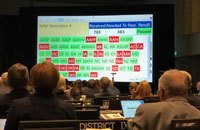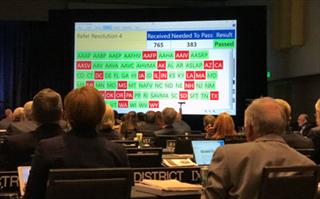
The American Veterinary Medical Association House of Delegates

VIN News Service photo
The American Veterinary Medical Association House of Delegates was divided concerning whether to refer an anti-debarking policy for continued study or vote on it, as is. The call to refer the policy won by a 1.2 percent margin.
American Veterinary Medical Association delegates stopped short last week of adopting a revised policy against debarking dogs, calling for more research.
The decision to punt the controversial initiative came a half-hour into debate on the floor of the AVMA House of Delegates, which met Friday in Denver for the group's annual meeting. Georgia delegate Dr. Seyedmehdi Mobini initiated the move with a question: "Is there a place to make a motion to refer this back for reconsideration by the Board of Directors?"
His colleagues — many of whom did not support the anti-debarking policy but hesitated to come out against it, fearing public backlash — referred the resolution to the board by the narrowest of margins: 50.6 percent.
It's uncertain whether the policy will reappear in time for the House's next meeting in January.
What's clear is that any revised stance the AVMA takes will draw detractors. The technical term for devocalization (or debarking, as it's commonly called) is ventriculocordectomy, which is a surgical procedure that involves removing tissue from an animal's vocal cords to permanently lower the volume of its vocalization.
Currently, the group advises that canine devocalization should be performed only "as an alternative to euthanasia" and after all efforts to stop a dog from excessively barking have been exhausted.
Drafted by the AVMA Animal Welfare Committee, the proposed new policy says the group is "opposed the nontherapeutic devocalization of dogs because of the surgery's negative impacts on animal welfare."
Ohio delegates voted against referring the revised policy for further study and spoke in favor it. Dr. Linda Lord, alternate delegate for Ohio, described barking as a "manifestation of severe anxiety and suffering" and said that devocalization removes "one of the animal's key way to communicate."
New York delegate Dr. Walter McCarthy countered that when behavior modification and drugs don't stop dogs from nuisance barking, veterinarians and owners often turn to euthanasia. "This procedure is not popular and it has problems, but there are rare cases where it should be done," he said.
To that, Lord asserted, "We euthanize for physical suffering; mental suffering is no different."
Dr. Apryl Steele, alternate delegate for the American Association of Feline Practitioners, agreed. "Incessant barking is difficult to deal with," she said. "… [B]ut because we can't hear it, that doesn't mean stress and anxiety has gone away. It tends to be a situational and environmental problem."
Rhode Island delegate Dr. Catherine Lund pointed out that AVMA policies are position statements — not regulatory code or law — and as such, they don't strip veterinarians of their autonomy. In other words, veterinarians are still free to debark dogs, even if the AVMA is positioned against it.
"It simply shows the public that we are passionate and concerned about a charge we should take seriously, and that's the welfare of animals. … We have all kinds of policies," she said, pointing to the AVMA's stance against tail docking as an example.
Opponents of the revised policy countered that such AVMA positions invite political scrutiny. In 2009, California became the first state to outlaw the routine tail docking of bovine, five years after the AVMA adopted a stance against the practice. California delegate Dr. Richard Sullivan asserted that state lawmakers used AVMA's position to support the initiative's passage.
"What AVMA says does have an impact on our legislatures," he said.
Lawmakers may make changes ahead of AVMA policy, as well. Anti-debarking bills have been introduced in both houses of the New York State Legislature, and bans exist in several states. Massachusetts, Maryland and New Jersey outlaw the procedure unless it's medically necessary. California and Rhode Island make it unlawful to require the devocalization of animals as a condition of real estate occupancy. Pennsylvania law specifies that the procedure must be performed by a licensed veterinarian using anesthesia.
Dr. Bill Grant, alternate delegate representing California, told the House that he's twice performed devocalization procedures. In both cases, his clients had been court-ordered to either re-home their incessantly barking dogs or have them debarked.
"We used a laser and had good results," he said. "These two animals went back [home], and we continued to see them for years after. It was a positive outcome."
Dr. Gregg Cutler, delegate for the American Association of Avian Pathologists, shared his personal experience devocalizing his wife's Sheltie, who "was just barking because she liked to bark." It was the early 1970s and Cutler had tried everything to stop it. Then a senior at the University of California-Davis School of Veterinary Medicine, he devocalized the dog under a faculty surgeon's guidance.
The dog, he said, was left with a hoarse bark that was much more tolerable to her owners.
Dr. Paul Tonioli, alternate delegate for Utah, said debarking is more like "depitching." "When I do this with my clients, it's the last resort," he said, "… and it doesn't really take away the bark."
Texas delegate Dr. Sam Miller wants the AVMA to stick with its old policy. "It addresses the spirit of what we like," he said. "We want this as a last resort, done by qualified licensed veterinarian as an alternative to euthanasia. It allows us the flexibility as veterinarians to do what is best for the patients and the clients."
Other resolutions
Two other, less controversial resolutions sailed past the House on Friday.
A resolution submitted by seven states called on the AVMA to collaborate with breed associations such as the American Kennel Club and Cat Fanciers' Association to develop recommendations for enhancing health-conscious breeding practices. The goal, the resolution says, is to minimize inherited disorders in dogs and cats.
A background statement on the resolution noted that veterinarians often are "caught in the middle" between treating patients and allowing deformities to continue. "Some say that by doing corrective surgeries and working with breeders, we are enabling the continuation of these disorders," the statement said.
The initiative passed unanimously. So did a resolution instructing AVMA to adopt a policy that supports establishing a U.S.-specific vaccine bank for foot and mouth disease. A highly infectious viral disease, FMD strikes hooved animals such as pigs, cattle and sheep. The virus can be financially devastating to agriculture and is endemic in many countries, though it has not been detected in the U.S. since 1929.